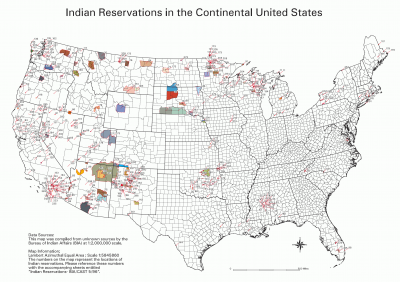THIS IS A DRAFT PAGE UNDER CONSTRUCTION - vectorspace
Background

There are a large number of roads, particularly in the western half of the United States, that are located on American Indian Reservations. There are about 310 such reservations as reviewed by the United States Department of the Interior's (DOI) Bureau of Indian Affairs (BIA). While the map shows only only the continental United States, reservations exists in Alaska and Hawaii.
These roads may be a mix of US government, public, tribal, and some private roads. Because most tribal lands are considered independent government entities, coordination and uniformity are not always clear. Public roads provide access to and within Indian reservations, Indian trust land, restricted Indian land, and Alaska native villages. Approximately 29,000 miles are under the jurisdiction of BIA and tribes and another 73,000 miles are under State and local ownership.
Waze & Reservation Roads
Tribal lands and Indian Reservations have resident communities that will utilize Waze, they are a destination for tourism, and they may be a critical viable route for travel through a region. Casinos are also located on a large number of reservations across the country, which will add more regular traffic to those regions. Because of this Waze editors should be concerned with a robust representation of roads and landmark content for these areas in the Waze Map.
This page provides some guidance on editing roads on these reservations as we seek to achieve these things in Waze editing:
- Common or standardized naming of roads
- Preventing routing through private roads
- Functional classification of roads to Waze road types.
- Identifying critical landmarks for navigation and destinations
Reservation Road Naming
As mentioned elsewhere in this article, the types of roads on an Indian Reservation can be of many types and coordination among Reservations and road-naming officials are not always clear. Because of this the following order of preference is suggested in how to name roads on an Indian Reservation unless there is a specific reservation standard:
- US Freeways
- US Highways
- State Highways
- As marked locally (check in person or use Street View)
- Example, "Tribal Road xxx"
- Example, "Navajo Road xxx"
- BIA-xxx for roads in the BIA-system
- IRR-xxx for roads with a route designation.
Waze base map naming conventions have been found to be somewhat random in rural areas. For example, a particular road may be named "Indian Service Route XXX," "Indian Service Rte XXX," "Indian Svc Rte XXX" along its length. Without higher-level precedent in the above list, it is suggested these all be named "IRR-xxx" for that road.
Specific Reservation Standards
Certain Indian Reservations, particularly those with larger regions, may have standards or preferences for road naming. This section is intended to identify those standards.
Located primarily in Arizona and New Mexico, this reservation has had names on the base map such as "Navajo Service Route," "Navajo Route," and others.
TBD - researching
Reservation Road Typing
The choice of road types (street, primary street, highway, etc.) for Indian Reservations, particularly those that are rural, may be different from urban areas. Many dirt roads are considered essential, are well maintained, and well traveled. These roads, although made of dirt, might be considered streets or primary streets in the region. If these roads are marked as dirt, they would be rendered less likely by Waze for routing.
Specific functional classification of Indian reservation roads may be found, in part, through the BIA database. This functional classification is not identical to Waze and other municipalities. It can be found
Reservation Landmarks
Landmarks on Indian Reservations should generally follow guidance for all landmarks in the United States. [link TBD] Specific guidance for Indian Reservations is as follows:
Landmarks to Consider
- Casinos (Map building and parking lot)
- Tourist Attractions
- Gas / Food / Lodging
Landmarks to Avoid
- Private religious areas
- Private ceremonial areas
- Other private areas
References
List of Indian Reservations
Wikipedia provides a List of Indian Reservations that might be useful at finding tribe-specific and reservation-specific details such as tourist attractions for landmarks, road names, etc.
Indian Reservation Road (IRR) Program
Details about the BIA's Indian Reservation Roads (IRR) Program can be found at their website. Utility of this information is that it provides access to a list of roads, although obscure, that might be useful in Waze editing.
The IRR Inventory is a database of all transportation facilities eligible for IRR Program funding and therefore will indicate ownership, the route number, may indicate that a BIA-xxx name is appropriate for a road, and identify the classification. The database is full of other information not relevant to Waze editing such as bridge numbers, traffic volumes, and maintenance responsibility.